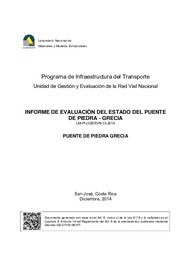| dc.contributor.author | Ruiz Cubillo, Paulo | |
| dc.contributor.author | Naranjo Ureña, Ronald | |
| dc.contributor.author | Garro Mora, José Francisco | |
| dc.contributor.author | Valverde Cordero, Christian | |
| dc.contributor.author | Quesada Campos, Josué | |
| dc.contributor.author | Muñoz Barrantes, Jorge | |
| dc.contributor.author | Vargas Alas, Luis Guillermo | |
| dc.contributor.author | Barrantes Jiménez, Roy | |
| dc.contributor.author | Loría Salazar, Luis Guillermo | |
| dc.date.accessioned | 2017-03-30T14:30:48Z | |
| dc.date.available | 2017-03-30T14:30:48Z | |
| dc.date.issued | 2014-12 | |
| dc.identifier.uri | https://www.lanamme.ucr.ac.cr/repositorio/handle/50625112500/99 | |
| dc.description.abstract | Funcionaros de la Unidad de Gestión y Evaluación de la Red Vial Nacional, Unidad de Gestión Municipal y la Unidad de Puentes, realizaron en el mes de octubre del presente año una gira de evaluación para determinar el estado del Puente de Piedra en el cantón de Grecia, esta estructura es patrimonio de natural de Costa Rica y su preservación es muy importante para el disfrute de las generaciones futuras. Entre los principales problemas que se encontraron están: La erosión producida por río Poró y drenajes en los taludes del puente, esto lo está afectando seriamente. La superficie de ruedo del puente y de las aproximaciones presentan problemas que generan infiltración de agua que afecta las rocas que forman el puente. La vegetación está teniendo un impacto negativo directo en el deterioro del puente. Las raíces de los árboles y plantas están aprovechando los espacios entre las columnas de las ignimbritas para crecer. Esto causa un ensanchamiento por un montículo de suelo y roca alterada en el sector oeste del puente que representa un serio problema de visibilidad. Se hacen recomendaciones para reducir el impacto de la meteorización biológica, la erosión fluvial y como mejorar la seguridad vial del puente. | es |
| dc.description.abstract | Workers from the Management and Evaluation of the National Road Network Unit, Municipal Management Unit and Bridge Unit, conducted an evaluation in October of this year to determine the status of the Stone Bridge in the canton of Grecia, this structure is natural heritage of Costa Rica and its preservation is very important for the enjoyment of future generations. Among the main problems found are: Erosion produced by the Poró river and drains on the slopes of the bridge, this is affecting seriously. The wearing surface of the bridge and nearby has problems that generate water infiltration affecting the rocks that form the bridge. The vegetation is having a direct negative impact on the deterioration of the bridge. The roots of trees and plants are taking advantage of the spaces between the columns of the ignimbrites to grow. This causes a widening by a mound of soil and rock altered in the western part of the bridge that is a serious problem of visibility. Recommendations to reduce the impact of biological weathering, fluvial erosion and to improve road safety of the bridge are made. | es |
| dc.language.iso | es | es |
| dc.publisher | Laboratorio Nacional de Materiales y Modelos Estructurales (LanammeUCR) | es |
| dc.relation.ispartofseries | LM-PI-UGERVN-13-2014 | |
| dc.subject | PITRA | es |
| dc.subject | Puente de Piedra Grecia | es |
| dc.subject | stone bridge Grecia | es |
| dc.title | Informe de evaluación del estado de puente de Piedra-Grecia | es |
| dc.type | informe técnico | es |
| dc.description.procedence | UCR::Vicerrectoría de Investigación::Unidades de Investigación::Ingeniería::LanammeUCR | es |

